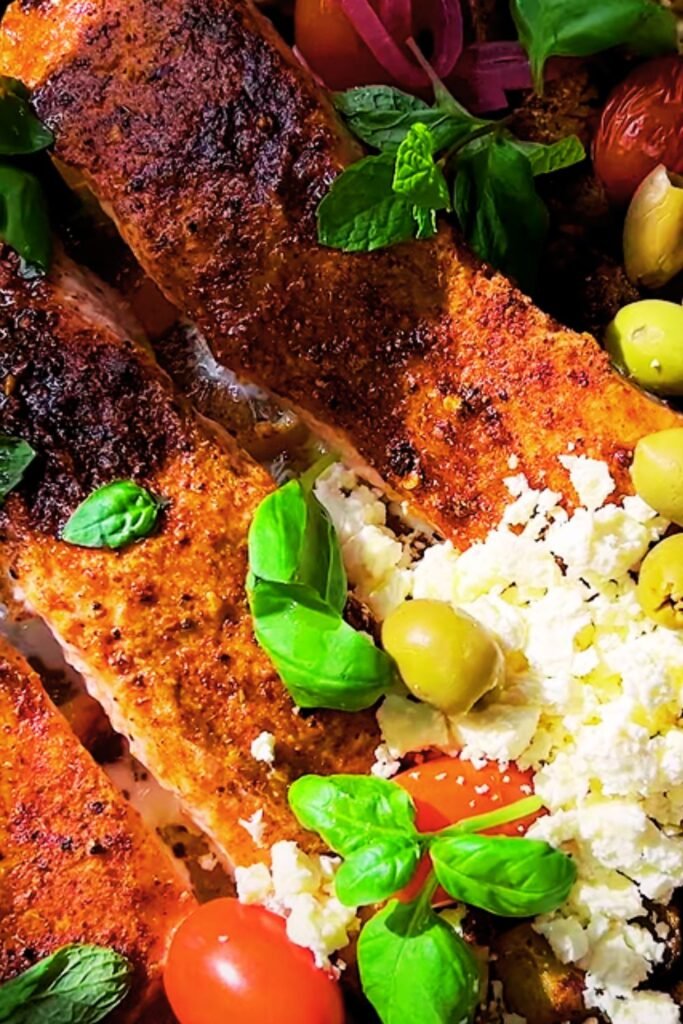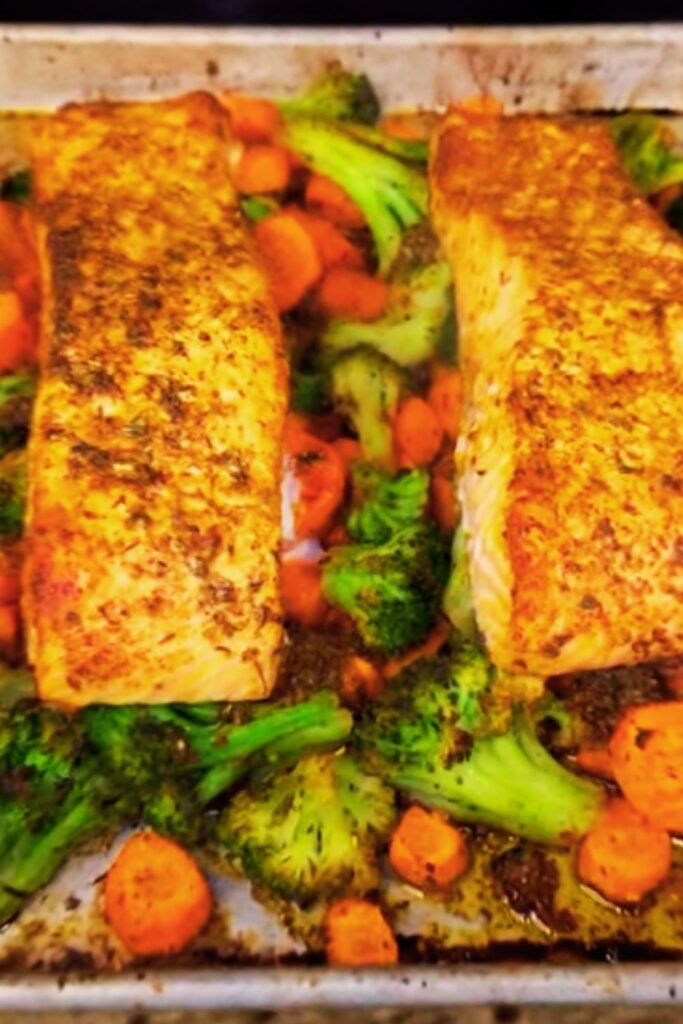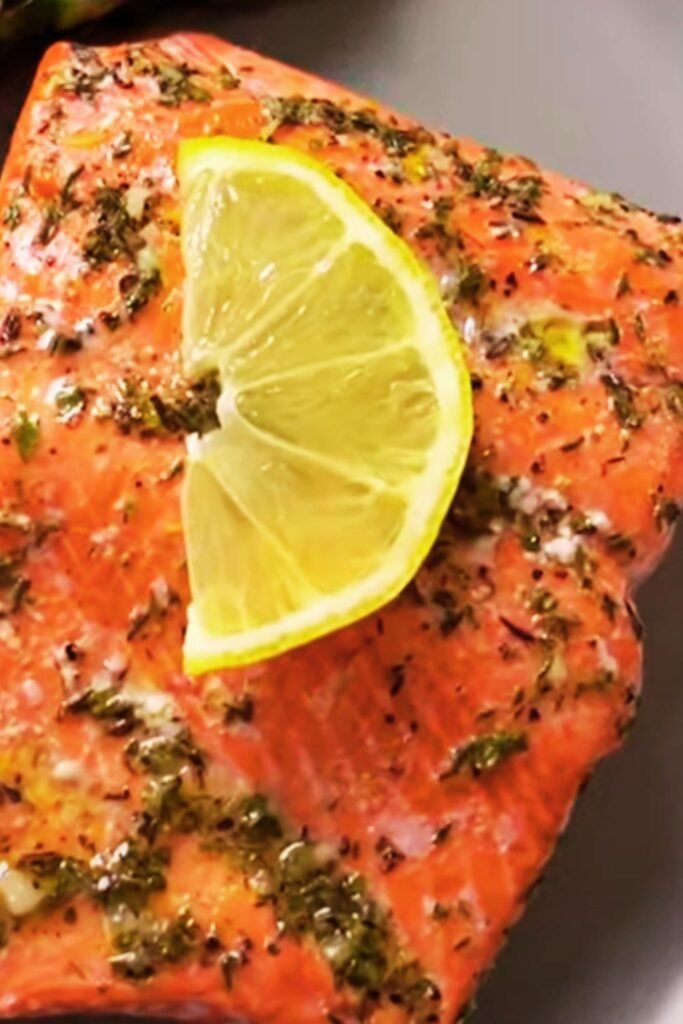I’ve been cooking sheet pan dinners for years, and I can confidently say that sheet pan salmon and vegetables is one of my absolute favorites. There’s something magical about throwing everything onto a single pan, sliding it into the oven, and emerging thirty minutes later with a complete, nutritious meal that looks like it came from a high-end restaurant.
When I first discovered sheet pan cooking, I was skeptical. How could something so simple produce results that were actually delicious? But after countless experiments in my kitchen, I’ve learned that the secret lies in understanding how different ingredients cook at different rates, mastering the art of seasoning, and knowing exactly when to add each component to achieve perfect harmony on your plate.
What Makes Sheet Pan Salmon So Special?
Sheet pan salmon represents the perfect marriage of convenience and sophistication. Unlike traditional cooking methods that require multiple pots, pans, and careful timing, this approach allows me to create a restaurant-quality meal with minimal cleanup and maximum flavor. The high heat of the oven caramelizes the vegetables while keeping the salmon moist and flaky, creating textural contrasts that make every bite interesting.
The beauty of this cooking method extends beyond convenience. When I arrange salmon and vegetables on the same pan, they actually enhance each other’s flavors. The salmon releases its natural oils, which mingle with the vegetable juices, creating a symphony of taste that’s impossible to achieve when cooking components separately.
Key Benefits of Sheet Pan Cooking
Efficiency: One pan, one oven, one cleanup session Flavor Enhancement: Ingredients cook together, sharing and intensifying flavors Nutritional Balance: Complete meal with protein, vegetables, and healthy fats Versatility: Endless combinations of vegetables and seasonings Time Management: Hands-off cooking allows me to focus on other tasks Portion Control: Easy to prepare exact serving sizes
Essential Ingredients for Perfect Sheet Pan Salmon
The Salmon Selection
Choosing the right salmon is crucial for success. I always opt for fresh, skin-on salmon fillets that are approximately 6-8 ounces each and about 1-1.5 inches thick. The skin helps protect the fish from overcooking and adds a delightful crispy texture when properly prepared.
Atlantic Salmon: Rich, buttery flavor with high fat content – perfect for beginners Sockeye Salmon: Deeper flavor, firmer texture, beautiful deep red color
Coho Salmon: Mild taste, medium fat content, excellent for those new to salmon King Salmon: Premium choice with highest fat content and most luxurious texture
Vegetable Categories and Cooking Times
Understanding vegetable cooking times is essential for achieving perfectly cooked components. I’ve learned to categorize vegetables based on their density and cooking requirements:
Hard Vegetables (35-40 minutes): Root vegetables like potatoes, carrots, parsnips, butternut squash Medium Vegetables (20-25 minutes): Brussels sprouts, cauliflower, sweet potatoes, beets Soft Vegetables (15-20 minutes): Zucchini, bell peppers, mushrooms, cherry tomatoes Delicate Vegetables (10-15 minutes): Asparagus, green beans, snap peas, broccoli

My Go-To Sheet Pan Salmon Recipe
Ingredients (Serves 4)
For the Salmon:
- 4 salmon fillets (6-8 oz each, skin-on)
- 2 tablespoons olive oil
- 1 teaspoon sea salt
- 1/2 teaspoon black pepper
- 1 teaspoon garlic powder
- 1 teaspoon dried herbs (thyme, oregano, or dill)
- 2 tablespoons fresh lemon juice
- 1 tablespoon honey (optional, for caramelization)
For the Vegetables:
- 1 lb baby potatoes, halved
- 2 large carrots, cut into 2-inch pieces
- 1 large red bell pepper, cut into strips
- 1 medium zucchini, sliced into rounds
- 1 cup cherry tomatoes
- 1 red onion, cut into wedges
- 3 tablespoons olive oil
- 1 teaspoon salt
- 1/2 teaspoon black pepper
- 1 teaspoon Italian seasoning
- 3 cloves garlic, minced
For Garnish:
- 2 tablespoons fresh parsley, chopped
- 1 lemon, cut into wedges
- 2 tablespoons capers (optional)
Step-by-Step Instructions
Preparation Phase:
- Preheat my oven to 425°F (220°C) and line a large sheet pan with parchment paper
- Pat salmon fillets completely dry with paper towels – this is crucial for proper searing
- Prepare all vegetables according to their cutting requirements
- Mix seasonings in small bowls for easy application
Vegetable Preparation:
- Toss the harder vegetables (potatoes and carrots) with 2 tablespoons olive oil, salt, pepper, and half the garlic
- Arrange these vegetables on one side of the prepared sheet pan
- Roast for 15 minutes to give them a head start
Adding Remaining Vegetables:
- Remove the pan from the oven and add bell peppers and onions
- Toss with remaining oil and seasonings
- Return to oven for another 10 minutes
Salmon Addition:
- Create space on the sheet pan for the salmon fillets
- Brush salmon with olive oil and season generously with salt, pepper, garlic powder, and herbs
- Drizzle with lemon juice and honey if using
- Place salmon skin-side down on the pan
- Add zucchini and cherry tomatoes around the salmon
Final Cooking:
- Return to oven for 12-15 minutes until salmon flakes easily with a fork
- Internal temperature should reach 145°F (63°C)
- Remove from oven and let rest for 3-5 minutes

Cooking Time and Temperature Chart
| Ingredient | Temperature | Initial Cook Time | With Salmon |
|---|---|---|---|
| Baby Potatoes | 425°F | 15 minutes | Additional 12-15 minutes |
| Carrots | 425°F | 15 minutes | Additional 12-15 minutes |
| Bell Peppers | 425°F | 10 minutes | Additional 12-15 minutes |
| Red Onion | 425°F | 10 minutes | Additional 12-15 minutes |
| Zucchini | 425°F | 0 minutes | 12-15 minutes |
| Cherry Tomatoes | 425°F | 0 minutes | 12-15 minutes |
| Salmon Fillets | 425°F | 0 minutes | 12-15 minutes |
Seasoning Combinations That Transform Your Meal
Mediterranean Magic
- 2 teaspoons dried oregano
- 1 teaspoon dried basil
- 1/2 teaspoon dried thyme
- 1 teaspoon garlic powder
- Zest of 1 lemon
- 2 tablespoons olive oil
- Finish with crumbled feta cheese and Kalamata olives
Asian-Inspired Fusion
- 2 tablespoons low-sodium soy sauce
- 1 tablespoon rice vinegar
- 1 teaspoon sesame oil
- 1 teaspoon fresh ginger, grated
- 1 clove garlic, minced
- 1/2 teaspoon red pepper flakes
- Garnish with sesame seeds and green onions
Herb Garden Fresh
- 2 tablespoons fresh dill, chopped
- 1 tablespoon fresh parsley, chopped
- 1 teaspoon fresh thyme leaves
- 2 cloves garlic, minced
- Zest and juice of 1 lemon
- 2 tablespoons olive oil
- Finish with a dollop of Greek yogurt
Cajun Spice Adventure
- 1 teaspoon paprika
- 1/2 teaspoon cayenne pepper
- 1/2 teaspoon oregano
- 1/2 teaspoon thyme
- 1/4 teaspoon garlic powder
- 1/4 teaspoon onion powder
- Salt and black pepper to taste
Nutritional Benefits Breakdown
| Nutrient | Amount per Serving | Daily Value % |
|---|---|---|
| Calories | 485 | 24% |
| Protein | 42g | 84% |
| Total Fat | 22g | 28% |
| Saturated Fat | 4g | 20% |
| Omega-3 Fatty Acids | 2.3g | 143% |
| Fiber | 6g | 21% |
| Vitamin C | 95mg | 106% |
| Vitamin A | 8,900 IU | 178% |
| Potassium | 1,250mg | 27% |
| Iron | 3.2mg | 18% |
This nutritional profile makes sheet pan salmon an excellent choice for heart health, brain function, and overall wellness. The omega-3 fatty acids support cardiovascular health, while the variety of vegetables provides essential vitamins, minerals, and antioxidants.
Troubleshooting Common Issues
Overcooked Salmon
Problem: Dry, flaky salmon that falls apart Solution: Reduce cooking time by 2-3 minutes and check internal temperature frequently. Remember that salmon continues cooking even after removal from the oven.
Undercooked Vegetables
Problem: Vegetables that are too crisp or raw in the center Solution: Cut vegetables into smaller, more uniform pieces and give harder vegetables extra cooking time before adding salmon.
Uneven Cooking
Problem: Some ingredients are overcooked while others are undercooked Solution: Arrange ingredients by cooking time requirements and add them in stages. Use a larger sheet pan if overcrowding is an issue.
Soggy Vegetables
Problem: Vegetables release too much moisture and become mushy Solution: Don’t overcrowd the pan, pat vegetables dry before seasoning, and use high heat to promote proper caramelization.
Serving Suggestions and Accompaniments
Grain-Based Sides
- Fluffy quinoa with lemon and herbs
- Wild rice pilaf with cranberries and almonds
- Garlic butter couscous with fresh parsley
- Brown rice with toasted pine nuts
Fresh Salad Pairings
- Arugula salad with balsamic vinaigrette
- Cucumber and tomato salad with fresh dill
- Mixed greens with avocado and lime dressing
- Spinach salad with strawberries and feta
Sauce Elevations
- Creamy dill sauce made with Greek yogurt
- Lemon herb butter with fresh chives
- Chimichurri with parsley and cilantro
- Hollandaise sauce for special occasions

Storage and Meal Prep Tips
Sheet pan salmon makes excellent meal prep, though I’ve learned some important tricks for maintaining quality. I store leftover salmon and vegetables in separate airtight containers in the refrigerator for up to 3 days. When reheating, I use the oven at 350°F for about 10 minutes rather than the microwave, which can make the salmon rubbery.
For meal prep success, I often prepare the vegetables ahead of time and store them seasoned in the refrigerator. This allows me to simply add the salmon and pop everything into the oven when I’m ready to cook. The salmon itself should be prepared fresh for the best texture and flavor.
Freezing Guidelines
- Cooked salmon can be frozen for up to 2 months
- Wrap individual portions tightly in plastic wrap, then aluminum foil
- Thaw overnight in refrigerator before reheating
- Vegetables don’t freeze well after cooking, so consume within 3 days
Seasonal Variations Throughout the Year
Spring Celebration
In spring, I love incorporating asparagus, sugar snap peas, and baby carrots with fresh herbs like chives and tarragon. The bright, clean flavors complement the salmon beautifully while celebrating the season’s fresh produce.
Summer Abundance
Summer calls for cherry tomatoes, zucchini, yellow squash, and fresh corn kernels. I often add fresh basil and oregano from my garden, creating a Mediterranean-inspired feast that captures summer’s essence.
Fall Comfort
Autumn brings butternut squash, Brussels sprouts, sweet potatoes, and red onions. I season everything with warming spices like thyme, rosemary, and a touch of maple syrup for natural sweetness.
Winter Warmth
Winter sheet pans feature hearty root vegetables like parsnips, turnips, and regular potatoes. I use robust herbs and sometimes add a honey glaze to create comfort food that satisfies during colder months.
Questions and Answers
Q: Can I use frozen salmon for this recipe? I don’t recommend using frozen salmon directly, but if that’s what you have, make sure to thaw it completely first. Pat it thoroughly dry and expect it to release more moisture during cooking, which might affect the final texture.
Q: How do I know when the salmon is perfectly cooked? The salmon should flake easily when tested with a fork and reach an internal temperature of 145°F. The flesh should be opaque and slightly firm but not dry. I usually check after 12 minutes and then every 2 minutes until it’s perfect.
Q: What’s the best way to prevent vegetables from sticking to the pan? I always use parchment paper or a silicone baking mat, and I make sure to use enough oil to coat the vegetables lightly. Don’t skip the oil – it’s essential for proper caramelization and prevents sticking.
Q: Can I make this recipe dairy-free? Absolutely! The basic recipe is naturally dairy-free. Just avoid any dairy-based seasonings or garnishes. Use olive oil instead of butter-based seasonings, and you’ll have a delicious dairy-free meal.
Q: How can I add more protein to make this more filling? While the salmon provides substantial protein, you could add chickpeas or white beans to the vegetable mix. Toss them with oil and seasonings and add them with the medium-cooking vegetables.
Q: Is it safe to eat the salmon skin? Yes! Salmon skin is not only safe but nutritious and delicious when properly cooked. The high heat creates a crispy texture that adds wonderful contrast to the flaky fish. Just make sure the skin is scaled and cleaned properly.
Q: Can I use different types of fish for this recipe? You can substitute other firm fish like cod, halibut, or sea bass, but adjust cooking times accordingly. Thinner fish will cook faster, while thicker pieces may need a few extra minutes.
Q: How do I prevent overcrowding on my sheet pan? Use a large, rimmed sheet pan (18×13 inches works best) and arrange ingredients in a single layer. If you need to cook for more people, use two sheet pans rather than overcrowding one.
Q: What’s the secret to getting crispy edges on the vegetables? High heat, proper oil coverage, and avoiding overcrowding are key. I also make sure vegetables are completely dry before oiling them, and I resist the urge to stir them too frequently during cooking.
Q: Can I prepare this recipe ahead of time? You can prep the vegetables and store them seasoned in the refrigerator for up to 24 hours. However, I recommend adding the salmon just before cooking for the best texture and food safety.
This sheet pan salmon and vegetables recipe has become a cornerstone of my weekly meal planning. It’s reliable, delicious, and endlessly adaptable to seasonal ingredients and personal preferences. Whether you’re cooking for family dinner or meal prepping for the week, this one-pan wonder delivers consistent results that never disappoint. The combination of perfectly cooked salmon with caramelized vegetables creates a satisfying meal that feels both healthy and indulgent – exactly what I want from my weeknight dinners.